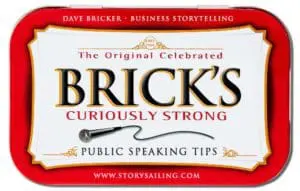 Dialogue…
Dialogue…
So many speakers miss this fantastic opportunity to engage the audience.
When it’s time for dialogue, they narrate it.
My wife walked in and she asked if I’d pick up some groceries on the way home from work.
I told her, “You know how much I love the grocery store, but I have to work late tonight.”
“Well,” she said.”You know how much I love to cook dinner but I have to eat out tonight!”
Let’s punch this up.
There are three characters in this scene.
Wait … you only see two?
We have you as the narrator, you in the story, and your wife. That’s three.
Let’s drop the dialogue tags—he said/she said—and use the stage to help tell the story.
As the narrator, I’ll talk directly to the audience.
To play myself in the story, I’ll step back into the past and off to one side—and I’ll look at the person I’m talking to.
When it’s my wife’s turn to speak, I’ll imitate her voice and face the spot where I was when I was speaking to her.
And my voice doesn’t have to convince anyone that I’m a woman; it just needs to cue the audience that a new, female character is speaking.
My wife walked in.
“Honey, do you mind picking up some groceries on the way home from work?”
“You know how much I love the grocery store, but I have to work late tonight.”
“Well, you know how much I love to cook dinner but I have to eat out tonight!”
Dialogue offers us a chance to bring our audiences right into a scene with us as the events unfold.
It’s real, visceral, present-tense, and super engaging.
And what advice do we always hear?
Show, don’t tell!





